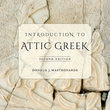 Accentuation Tutorial
Accentuation Tutorial

|
TOPICS Accent and Accent-Marking in Ancient Greek The Last 3 Syllables and the Accents Persistent Accentuation |
The circumflex accent ( In addition, it is a rule in ancient Greek that an accented long P that is followed by short U must have the circumflex. Conversely, an accented long P that is followed by long U must have the acute. στρατιῶται – circumflex on long P (only with short U) δῶρον – circumflex on long P (only with short U) ἀρχαῖος – circumflex on long P (only with short U) ὁδοῦ – circumflex on long U ἀρετῇ – circumflex on long U |
||||